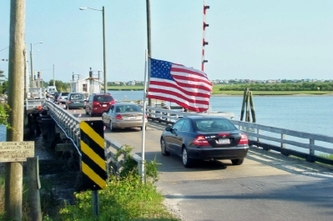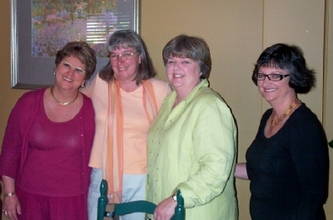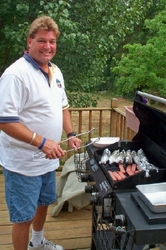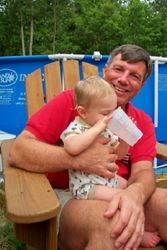
We are on our way north, heading for New England to visit our friends there. We’ve left the car behind in southern Virginia and are now finally sailing again, as we make our way from Hampton north in the Chesapeake Bay. Gale force winds in the northern Atlantic convinced us to take the inside route (i.e, travel the Bay), instead of making the faster hop outside from Norfolk to Cape May, NJ. We don’t mind traveling the length of the Bay, but it will add a few days to our trip.

Rainbow over Point Comfort as we leave Hampton
We’ve spent the last 2 weeks continuing to enjoy visits with family and friends, including a week at Sunset Beach with Cathy’s family (where they had a surprise 50th celebration for Cathy), a couple of nights in Reston with our friend Cookie, and more trips to Jarratt/Skippers to spend time with the kids and grandkids, including a pig roast the weekend before we left. We also got to know our neighbor at Joys Marina, Steve on Bay Dreamer, a little better, enjoying a BBQ at his house and a day sail on the bay on his boat with someone else as captain.
Hello, this is Ireland . . .
Between trips to visit family and friends, we squeezed in some time to work on some projects on the boat. The biggest of these was the ham radio installation. We had to plan out where the various components would be mounted and how we would route the wires between them. After rejecting some less desirable locations (e.g., under the floor boards, in the galley cupboard (Cathy vetoed that one), in the aft cabin, etc.), we decided to mount the radio itself under the nav station, with the face plate (tuner and microphone) just above the nav station. The antenna tuner would have to be in the aft cabin near the backstay that would support the antenna. We found a compartment next to the bed that would easily hold the tuner and the wires leading to it.
Next we had to find a path to send the wires from tuner to radio that would not have them dangling in view. We found a path under the bed, through the clothes locker, holding tank cabinet, behind the medicine cabinet and into the circuit panel by the nav station. The next decision was routing the copper ground strap ( a 4” wide thin copper roll) from the antenna tuner to a ground. After consulting several people, including the local marine electronics dealer at our marina, Dave decided to use the engine block as the ground, making for a short run under the bed (and fuel tank) in the aft cabin, under the floor to the engine.
After mounting all the internal components, we had to decide how to rig an antenna. We originally planned to run a wire next to the backstay for the antenna, but further discussion about the mechanics of doing this, caused Dave to reconsider this approach in favor of a simpler option. He ran a short wire to the backing plate of the backstay, effectively creating a loop antenna, using the backstay and forestay. The concern about this approach is the risk of RF burns if someone touches the rigging while transmitting. In a ceter cockpit, the backstay is more removed from those in the cockpit, and therefore the risk of accidentally getting burned is much lower. Also, the backstay is grounded, which is a little odd, but it works.
With a ham radio installation, there are so many variables, that the only way to be sure you’ve got it right is to turn the radio on and see what happens. Before rigging the antenna, Dave tried transmitting with a thin wire run up the spinnaker halyard. He was successful in talking to someone in northern Ireland with this set-up. Next, he rigged a temporary connection to the backstay to test this approach, and was successful in talking to Rhode Island and Florida. Finally, he connected the permanent cable, and verified the connection one last time. He talked to someone in Nebraska, Canada and Florida. It seemed the installation was a success!
Now, all we have to do is remember the phonetic alphabet. “This is Kilo India Four Quebec Oscar India calling Victor Alhpa Two Delta . . . “. You see what I mean.
Skin Care
Cathy continues to be plagued by problems with her eyes and skin. To try to solve some of these problems, we ordered an ozone generator to address problems that might exist with the air in the boat. This will be used only once a month or so to deliver a high-ozone shock treatment, which should kill any mold and mildew in the air. A visit to the dermatologist yielded more advice and prescriptions for better sunscreen, skin repair lotions and treatment for eczema. Armed with this new supply, she’s hoping she can brave the heat and humidity of the Chesapeake and the cold winds of the fall trip south.
Getting ready to go
As the date approached for departing, the list of things to do while ashore seemed to get longer. We still had to finish with the various doctor visits, and Dave ordered some prescription sunglasses to make it a little easier to see what’s out there.
We had a number of jobs to take care of on the boat before we could get underway again. After two months in a slip, despite our efforts to keep Orion moving once a week, it was obvious from her increasing drag, that the running gear was pretty badly fouled. We arranged for a diver to come clean the running gear, scrape the growth off the bottom and replace the zinc. (Luckily, we still had some zinc left, but it was getting pretty thin.) After trying to actually sail on our last weekly outing, we realized the outhaul was showing wear, and was therefore making it much more difficult to furl and unfurl the main. Dave replaced the line and saw a distinct improvement in our first sail using it.
Since we would be traveling in new territory north of the Chesapeake, we needed to purchase the necessary charts, both paper and electronic, and load the electronic ones on the computer and chart plotter. In addition, Dave downloaded the latest NOAA charts.
When we last replaced the starting battery, Dave had kept the old one, since he wasn’t entirely sure it was bad. He took the time to wire it into the battery charger, so that it can be used as a spare starting battery in an emergency.
We changed oil, made several grocery runs to re-provision, re-filled the water and propane tanks, mapped out routes for inside and outside alternatives and began stowing all the “stuff” that gets strewn about when you sit for a while. While we were so close to Annapolis, we stopped by to get more zincs from Annapolis Yacht Sales and oil and fuel filters from Bayshore Marine.
Finally, we tetuned our car to our son’s house, where it will stay for the time being, and made our way back to the boat for an early departure the next day.
Within moments of leaving the Hampton River, we were under sail, which was a nice way to start out the trip. Now, if we can just avoid those famous Chesapeake thunder storms . . .
Between trips to visit family and friends, we squeezed in some time to work on some projects on the boat. The biggest of these was the ham radio installation. We had to plan out where the various components would be mounted and how we would route the wires between them. After rejecting some less desirable locations (e.g., under the floor boards, in the galley cupboard (Cathy vetoed that one), in the aft cabin, etc.), we decided to mount the radio itself under the nav station, with the face plate (tuner and microphone) just above the nav station. The antenna tuner would have to be in the aft cabin near the backstay that would support the antenna. We found a compartment next to the bed that would easily hold the tuner and the wires leading to it.
Next we had to find a path to send the wires from tuner to radio that would not have them dangling in view. We found a path under the bed, through the clothes locker, holding tank cabinet, behind the medicine cabinet and into the circuit panel by the nav station. The next decision was routing the copper ground strap ( a 4” wide thin copper roll) from the antenna tuner to a ground. After consulting several people, including the local marine electronics dealer at our marina, Dave decided to use the engine block as the ground, making for a short run under the bed (and fuel tank) in the aft cabin, under the floor to the engine.
After mounting all the internal components, we had to decide how to rig an antenna. We originally planned to run a wire next to the backstay for the antenna, but further discussion about the mechanics of doing this, caused Dave to reconsider this approach in favor of a simpler option. He ran a short wire to the backing plate of the backstay, effectively creating a loop antenna, using the backstay and forestay. The concern about this approach is the risk of RF burns if someone touches the rigging while transmitting. In a ceter cockpit, the backstay is more removed from those in the cockpit, and therefore the risk of accidentally getting burned is much lower. Also, the backstay is grounded, which is a little odd, but it works.
With a ham radio installation, there are so many variables, that the only way to be sure you’ve got it right is to turn the radio on and see what happens. Before rigging the antenna, Dave tried transmitting with a thin wire run up the spinnaker halyard. He was successful in talking to someone in northern Ireland with this set-up. Next, he rigged a temporary connection to the backstay to test this approach, and was successful in talking to Rhode Island and Florida. Finally, he connected the permanent cable, and verified the connection one last time. He talked to someone in Nebraska, Canada and Florida. It seemed the installation was a success!
Now, all we have to do is remember the phonetic alphabet. “This is Kilo India Four Quebec Oscar India calling Victor Alhpa Two Delta . . . “. You see what I mean.
Skin Care
Cathy continues to be plagued by problems with her eyes and skin. To try to solve some of these problems, we ordered an ozone generator to address problems that might exist with the air in the boat. This will be used only once a month or so to deliver a high-ozone shock treatment, which should kill any mold and mildew in the air. A visit to the dermatologist yielded more advice and prescriptions for better sunscreen, skin repair lotions and treatment for eczema. Armed with this new supply, she’s hoping she can brave the heat and humidity of the Chesapeake and the cold winds of the fall trip south.
Getting ready to go
As the date approached for departing, the list of things to do while ashore seemed to get longer. We still had to finish with the various doctor visits, and Dave ordered some prescription sunglasses to make it a little easier to see what’s out there.
We had a number of jobs to take care of on the boat before we could get underway again. After two months in a slip, despite our efforts to keep Orion moving once a week, it was obvious from her increasing drag, that the running gear was pretty badly fouled. We arranged for a diver to come clean the running gear, scrape the growth off the bottom and replace the zinc. (Luckily, we still had some zinc left, but it was getting pretty thin.) After trying to actually sail on our last weekly outing, we realized the outhaul was showing wear, and was therefore making it much more difficult to furl and unfurl the main. Dave replaced the line and saw a distinct improvement in our first sail using it.
Since we would be traveling in new territory north of the Chesapeake, we needed to purchase the necessary charts, both paper and electronic, and load the electronic ones on the computer and chart plotter. In addition, Dave downloaded the latest NOAA charts.
When we last replaced the starting battery, Dave had kept the old one, since he wasn’t entirely sure it was bad. He took the time to wire it into the battery charger, so that it can be used as a spare starting battery in an emergency.
We changed oil, made several grocery runs to re-provision, re-filled the water and propane tanks, mapped out routes for inside and outside alternatives and began stowing all the “stuff” that gets strewn about when you sit for a while. While we were so close to Annapolis, we stopped by to get more zincs from Annapolis Yacht Sales and oil and fuel filters from Bayshore Marine.
Finally, we tetuned our car to our son’s house, where it will stay for the time being, and made our way back to the boat for an early departure the next day.
Within moments of leaving the Hampton River, we were under sail, which was a nice way to start out the trip. Now, if we can just avoid those famous Chesapeake thunder storms . . .









